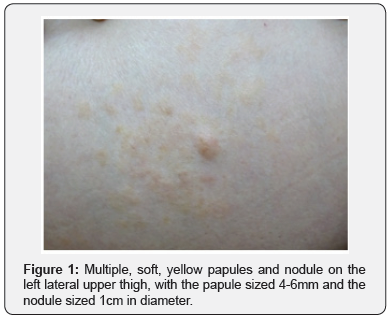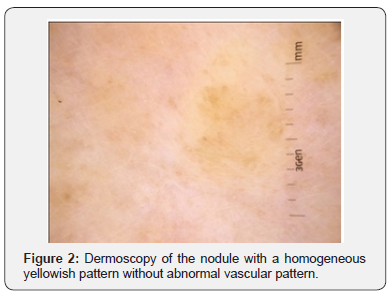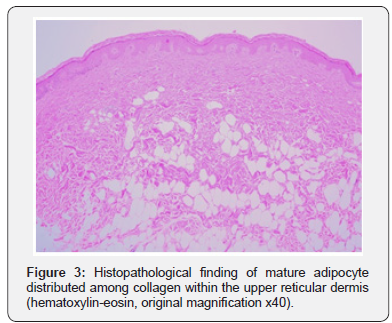Uncommon Elderly-Onset Nevus Lipomatosus Cutaneous Superficialis: A Case Report with Dermoscopic and Histopathologic Correlation
Suparuj Lueangarun1*, and Therdpong Tempark2
1Division of Dermatology, Thammasat University, Thailand
2 Department of Pediatrics, Chulalongkorn University, Thailand
Submission:May 07, 2018; Published: May 11, 2018 ;
*Corresponding author: Suparuj Lueangarun, Division of Dermatology, Chulabhorn International College of Medicine, Thammasat University, Amphur Klongluang, Thailand.
How to cite this article: Suparuj Lueangarun, Therdpong Tempark. Uncommon Elderly-Onset Nevus Lipomatosus Cutaneous Superficialis: A Case Report with Dermoscopic and Histopathologic Correlation. Dermatol & Cosmet JOJ. 2018; 1(1): 555552. 10.19080/JOJDC.2018.01.555552
Abstract
Nevus lipomatosus cutaneous superficialis (NLCS) is a rare hamartoma of the skin characterized by histological presence of ectopic mature adipocyte in the dermis. We presented an uncommon case of the adult-onset classical form of NLCS, with the correlations between dermoscopy and histopathology of homogenous yellowish area, corresponding to the histological finding of mature fat cell in upper dermisfor the diagnosis of this type of skin condition.
Keywords: Nevus lipomatosus cutaneous superficialis; Hamartoma; Dermoscopy; Histopathology
Introduction
Nevus lipomatosus cutaneous superficialis (NLCS) is a rare cutaneous hamartoma histologically characterized by the group of mature adipocyte presenting among the collagen bundles of the dermis. Clinically, this condition is classified into 2 types:
a) a classical or multiple type, usually presented at birth or in the first two to three decades of life with the clinical group of soft, painless, cerebriform, pedunculated, yellowish or skin colored papules or nodules, and
b) a solitary type, usually developed in adults with solitary papule or nodule. Most importantly, few cases of adult-onset multiple types of NLCS were reported [1-3].
Case Report
A 74-year-old female presented with the 1-year history of progressively increased numbers and sizes of asymptomatic yellowish papules on the left upper thigh. She was otherwise in good health even with her insignificant medical history. As well, there was no history of local trauma, rubbing or scratching of the affected sites, atopy or other significant underlying problems, and no related Cutaneous problem in family members.Besides, physical examination revealed groups of multiple, soft, smooth, yellow-colored papules and nodule on left upper lateral thigh, approximately 12 x 10 cm in size, and the largest nodule of 1cm in diameter (Figure 1).

Whereas, the dermoscopic examination demonstrated multiple well-circumscribed, homogeneous faint yellowish areas without abnormal vascular structure (Figure 2). Moreover, the histopathologic examination from the largest nodule showed multiple nests of lipocytes in the upper and mid dermis, with the absence of skin appendages in this area, and normal overlying epidermis (Figure 3). Hence, the diagnosis of nevus lipomatosus cutaneous superficialis (NLCS) was confirmed.


Discussion
NLCS is a rare connective tissue hamartoma histologically characterized by the presence of ectopic mature adipose tissue in the superficial dermis. NLCS has been classified into two clinical forms: a multiple or classic form and a solitary form [4]. The classic form always presents at birth or develops during the first two decades of life, clinically with grouped, fleshy, skin-colored to yellowish papules and nodules on the lower trunk, buttocks or thighs in a segmental distribution. Meanwhile, the solitary form often occurs during adulthood as a solitary papule or nodule anywhere on the skin. Interestingly, our case presented the uncommon case of classical multiple form NLCS in the elderly, [1-3] mostly found at birth or within the first two decade of life.
According to the postulated hypotheses of NLCS, degenerative changes in dermal collagens and elastic tissues lead to fat cell depositions among collagen bundles in superficial dermis [5] and then precursor mesenchymal perivascular cells develop to adipocyte in the dermis [6]. However, the genetic defect of NLCS is still uncertain with only one cytogenetic reported study of the 2p24 deletion [7].
Our differential diagnoses include smooth muscle hamartoma, plexiform neurofibroma, cutaneous leiomyoma, and xanthogranuloma. Whilst, the definite diagnosis requires histopathologic study to yield the characteristically histopathologic finding of ectopic mature adipocytes lying within the upper reticular dermis between collagen bundles and around the blood vessels of the papillary dermis [8].
Additionally, the role of dermoscopyis crucial as a noninvasive and useful tool for the diagnosis of many pigmented and non-pigmented cutaneous lesions. In our present case, the dermoscopic finding of homogeneous yellowish area corresponds to the adipocyte in the dermis, and the lack of vascular structure is also correlated with most components of mature fat cells in the dermis with rare dilated capillaries from histology.
Furthermore, the yellowish color of fatty tissue findings from dermoscopy also provide useful information for the diagnosis of other skin conditions with adipocyte components such as cutaneous lipomatous neuro fibroma [9]. However, the various shades of homogeneous yellow color on dermoscopic finding have been described in another condition including sebaceous glands hyperplasia, tumors with sebaceous differentiation [10], and dermal xanthomatous deposition diseases such as xanthomatous dermatofibroma, reticulohistiocytoma, and adult xanthogranuloma [11]. Particularly, Juvenile xanthogranulomareveals the characteristically dermoscopic findings of the ‘setting sun’ appearance with the orange-yellow background of a subtle erythematous border [12].
In the meantime, treatment for NLCS is unnecessary, except for cosmetic reasons. Following the conservative approach of reported treatment, the lesions however tend to increase in size and number, while occasionally present with rare ulcerated complication [13].
Moreover, liquid nitrogen cryotherapy has been reported in individual lesions with a partial response [14]. Nevertheless, there is only one report that shows the effectiveness of CO2 laser ablation therapy for classic NLCS [15]. Thus, the treatment of choice seems to be the surgical excision. However, the classic form of clustered lesions is still limited, in term of large area involvement.Also, no recurrence and malignant transformation has never been before reported [4].
Conclusion
We report a rare case of adult-onset classical NLCS on the left lateral upper thigh, with the dermoscopic finding of homogenous yellowish area corresponding to the histological finding of mature fat cells in the upper dermis for the diagnosis implementation of this skin condition.
References
- Gutierrez-Gonzalez E, Montero I, Sanchez-Aguilar D, Ginarte M, Toribio J (2014) Adult-onset verrucous nevus lipomatosus cutaneous superficialis. Int J Dermatol 53(1): 69-71.
- Dhar S, Kumar B, Kaur I (1994) Naevus lipomatosus superficialis of Hoffman and Zurhelle. Indian J Dermatol Venereol Leprol 60(1): 39-40.
- Ghosh SK, Bandyopadhyay D, Jamadar NS (2010) Nevus lipomatosus cutaneous superficialis: An unusual presentation. Dermatol Online J 16(7): 12.
- Jones EW, Marks R, Pongsehirun D (1975). Naevus superficialis lipomatosus. A clinicopathological report of twenty cases. Br J Dermatol 93(2): 121-133.
- Holtz KH (1955) Histology of naevus lipomatodes cutaneous superficialis (Hoffmann-Zurelle). Arch Klin Exp Dermatol. 199(3): 275- 286.
- Holtz KH. Histology of naevus lipomatodes cutaneous superficialis (Hoffmann-Zurelle). 19551201 DCOM- 20030501 (0300-8614 (Print)).
- Cardot-Leccia N, Italiano A, Monteil MC, Basc E, Perrin C, et al, (2007) Naevus lipomatosus superficialis: a case report with a 2p24 deletion. Br J Dermatol 156(2): 380-381.
- Hoffmann E, Zurhelle E (1921) Uber einen Naevus lipomatodes cutaneous superficialis der linken Glutaalgegend. Arch Dermatol Syphilol 130: 327-333.
- Yoshida Y, Yamamoto O (2009) Cutaneous lipomatous neurofibroma. J Dermatol 36(12): 674-675.
- Kim NH, Zell DS, Kolm I, Oliviero M, Rabinovitz HS (2008) The dermoscopic differential diagnosis of yellow lobular like structures. Arch Dermatol 144(7): 962
- Cavicchini S, Tourlaki A, Tanzi C, Alessi E (2008) Dermoscopy of solitary yellow lesions in adults. Arch Dermatol 144(10): 1412.
- Palmer A, Bowling J (2007) Dermoscopic appearance of juvenile xanthogranuloma. Dermatology 215(3): 256-259.
- Yap FB (2009) Nevus lipomatosus superficialis. Singapore Med J 50(5): 161-162.
- Al-Mutairi N, Joshi A, Nour-Eldin O (2006) Naevus lipomatosus cutaneous superficialis of Hoffmann-Zurhelle with angiokeratoma of Fordyce. Acta Derm Venereol 86(1): 92-93.
- Fatah S, Ellis R, Seukeran DC, Carmichael AJ (2010) Successful CO2 laser treatment of naevus lipomatosus cutaneous superficialis. Clin Exp Dermatol 35(5): 559-560.






























